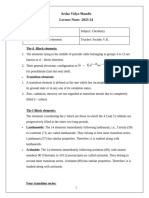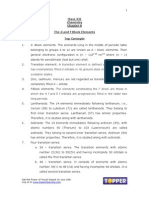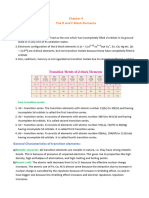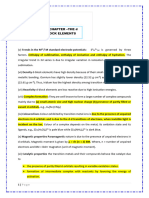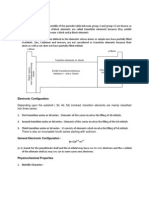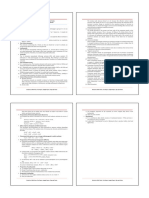njesc108
njesc108
Uploaded by
Chirag ChauhanCopyright:
Available Formats
njesc108
njesc108
Uploaded by
Chirag ChauhanCopyright
Available Formats
Share this document
Did you find this document useful?
Is this content inappropriate?
Copyright:
Available Formats
njesc108
njesc108
Uploaded by
Chirag ChauhanCopyright:
Available Formats
CBSE Class 12 Chemistry
Quick Revision Notes
Chapter 8
The D and F-Block Elements
The d -Block elements:
1. The elements lying in the middle of periodic table belonging to groups 3 to 12 are known
as d – block elements.
2. Their general electronic configuration is where (n – 1) stands for
penultimate (last but one) shell.
Transition element:
1. A transition element is defined as the one which has incompletely filled d orbitals in its
ground state or in any one of its oxidation states.
2. Zinc, cadmium, mercury are not regarded as transition metals due to completely filled d –
orbital.
The f-Block elements: The elements constituting the f -block are those in which the 4
f and 5 f orbitals are progressively filled in the latter two long periods.
Lanthanoids: The 14 elements immediately following lanthanum, i.e., Cerium (58) to
Lutetium (71) are called lanthanoids. They belong to first inner transition series.
Lanthanum (57) has similar properties. Therefore, it is studied along with
lanthanoids.
Actinoids: The 14 elements immediately following actinium (89), with atomic
numbers 90 (Thorium) to 103 (Lawrencium) are called actinoids. They belong to
second inner transition series. Actinium (89) has similar properties. Therefore, it is
studied along with actinoids.
Four transition series:
1. 3d – transition series. The transition elements with atomic number 21(Sc) to 30(Zn) and
having incomplete 3d orbitals is called the first transition series.
Material downloaded from myCBSEguide.com. 1/4
2. 4d – transition series. It consists of elements with atomic number 39(Y) to 48 (Cd) and
having incomplete 4d orbitals. It is called second transition series.
3. 5d – transition series. It consists of elements with atomic number 57(La), 72(Hf) to 80(Hg)
having incomplete 5d orbitals. It is called third transition series.
4. 6d – transition series. It consists of elements with atomic number 89(Ac), 104(Rf) to
112(Uub) having incomplete 6d orbitals. It is called fourth transition series.
General Characteristics of transition elements:
a) Metallic character: All transition elements are metallic in nature, i.e. they have strong
metallic bonds. This is because of presence of unpaired electrons. This gives rise to
properties like high density, high enthalpies of atomization, and high melting and boiling
points.
b) Atomic radii: The atomic radii decrease from Sc to Cr because the effective nuclear
charge increases. The atomic size of Fe, Co, Ni is almost same because the attraction due to
increase in nuclear charge is cancelled by the repulsion because of increase in shielding
effect. Cu and Zn have bigger size because the shielding effect increases and electron
electron repulsions repulsion increases.
c) Lanthanoid Contraction: The steady decrease in the atomic and ionic radii of the
transition metals as the atomic number increases. This is because of filling of 4f orbitals
before the 5d orbitals. This contraction is size is quite regular. This is called lanthanoid
contraction. It is because of lanthanoid contraction that the atomic radii of the second row of
transition elements are almost similar to those of the third row of transition elements.
d) Ionisation enthalpy: There is slight and irregular variation in ionization energies of
transition metals due to irregular variation of atomic size. The I.E. of 5d transition series is
higher than 3d and 4d transition series because of Lanthanoid Contraction.
e) Oxidation state: Transition metals show variable oxidation states due to tendency of (n-
1)d as well as ns electrons to take part in bond formation.
f) Magnetic properties: Most of transition metals are paramagnetic in nature as a result of
which they give coloured compounds and it is all due to presence of unpaired electrons. It
increase s from Sc to Cr and then decreases because number of unpaired and then decrease
because number of unpaired electrons increases from Sc to Cr and then decreases. They are
rarely diamagnetic.
g) Catalytic properties: Most of transition metals are used as catalyst because of (i) presence
Material downloaded from myCBSEguide.com. 2/4
of incomplete or empty d – orbitals, (ii) large surface area, (iii) varuable oxidation state, (iv)
ability to form complexes, e.g., Fe, Ni, V2O3, Pt, Mo, Co and used as catalyst.
h) Formation of coloured compounds: They form coloured ions due to presence of
incompletely filled d – orbitals and unpaired electrons, they can undergo d – d transition by
absorbing colour from visible region and radiating complementary colour.
i) Formation of complexes: Transition metals form complexes due to (i) presence of vacant
d – orbitals of suitable energy (ii) smaller size (iii) higher charge on cations.
j) Interstitial compounds: Transition metals have voids or interstitials in which C, H, N, B
etc. can fit into resulting in formation of interstitial compounds. They are non –
stoichiometric, i.e., their composition is not fixed, e.g., steel. They are harder and less
malleable and ductile.
k) Alloys formation: They form alloys due to similar ionic size. Metals can replace each
other in crystal lattice, e.g., brass, bronze, steel etc.
Preparation of Potassium dichromate ( ): It is prepared by fusion of
chromate ore (FeCr2O4) with sodium carbonate in excess of air.
Effect of pH on chromate and dichromate ions: The chromates and dichromates are
inter-convertible in aqueous solution depending upon pH of the solution. The
oxidation state of chromium in chromate and dichromate is the same.
Potassium dichromate acts as a strong oxidizing agent in acidic medium:
Preparation of Potassium permanganate (KMnO4):
a) Potassium permanganate is prepared by fusion of MnO4 with alkali metal hydroxide
(KOH) in presence of O2 or oxidising agent like KNO3. It produces dark green K2MnO4 which
undergoes oxidation as well as reduction in neutral or acidic solution to give permanganate.
Material downloaded from myCBSEguide.com. 3/4
b) Commercially, it is prepared by the alkaline oxidative fusion of MnO2 followed by the
electrolytic oxidation of manganate (Vl).
c) In laboratory, Mn²+ salt can be oxidized by peroxodisulphate ion to permanganate ion.
In acidic medium:
In neutral or faintly basic medium:
Properties of Lanthanoids:
1. +3 oxidation state is most common along with +2 and +4.
2. Except Promethium, they are non – radioactive.
3. The magnetic properties of lanthanoids are less complex than actinoids.
Properties of Actinoids:
1. Actinoids also show higher oxidation states such as +4, +5, +6 and +7.
2. They are radioactive.
3. The magnetic properties of the actinoids are more complex than those of the lanthanoids.
4. They are more reactive.
Mischmetall
1. It is a well-known alloy which consists of a lanthanoid metal and iron
and traces of S, C, Ca and Al.
2. A good deal of mischmetall is used in Mg-based alloy to produce bullets, shell and lighter
flint.
Material downloaded from myCBSEguide.com. 4/4
You might also like
- D and F Block ElementsDocument51 pagesD and F Block ElementsSatlip33% (3)
- Chemistry: a QuickStudy Laminated Reference GuideFrom EverandChemistry: a QuickStudy Laminated Reference GuideRating: 4.5 out of 5 stars4.5/5 (2)
- DIN 17100 Steels For General Structural Purposes (DIN17100)Document7 pagesDIN 17100 Steels For General Structural Purposes (DIN17100)tiwariNo ratings yet
- Gold Amalgamation: Mercury, A Brief HistoryDocument37 pagesGold Amalgamation: Mercury, A Brief HistoryAFLAC ............100% (3)
- Chemistry 8Document4 pagesChemistry 8sivarigil610No ratings yet
- file_1696483397_Lecture notes_d and f blockDocument5 pagesfile_1696483397_Lecture notes_d and f blockaparjagan07No ratings yet
- Chemistry Formula D and F Block ElementsDocument6 pagesChemistry Formula D and F Block Elementsom popalghatNo ratings yet
- 12 Chemistry Notes Ch08 The Dblock F-Block ElementsDocument4 pages12 Chemistry Notes Ch08 The Dblock F-Block ElementsSwaroop SurendraNo ratings yet
- CBSE Class-12 Chemistry Quick Revision Notes Chapter-08: The D and F-Block ElementsDocument4 pagesCBSE Class-12 Chemistry Quick Revision Notes Chapter-08: The D and F-Block ElementsSAKET TYAGI100% (2)
- CBSE Class 12 Chemistry Notes Chapter 8 The DDocument7 pagesCBSE Class 12 Chemistry Notes Chapter 8 The Ddebu9131No ratings yet
- D & F Block ElementsDocument5 pagesD & F Block ElementsSachinNo ratings yet
- XII Chem Ch8 Thed&f-blockElements ChapterNotesDocument5 pagesXII Chem Ch8 Thed&f-blockElements ChapterNotesPrashant ChawlaNo ratings yet
- The d and f Block Elements-Notes (1)Document5 pagesThe d and f Block Elements-Notes (1)Aditya RiseNo ratings yet
- Developed by TeacherDocument5 pagesDeveloped by TeachermisspayujiNo ratings yet
- 12 Chemistry Notes Ch08 The Dblock F-Block ElementsDocument5 pages12 Chemistry Notes Ch08 The Dblock F-Block ElementsjdishvanthdishvanthNo ratings yet
- 10 - D - and F - Block Elements PDFDocument18 pages10 - D - and F - Block Elements PDFthinkiit100% (19)
- Chapter 8 PDFDocument4 pagesChapter 8 PDFChristeena HenryNo ratings yet
- D and F BlockDocument15 pagesD and F Blockthinkiit100% (1)
- 12 Chemistry Notes Ch08 The Dblock F-Block ElementsDocument4 pages12 Chemistry Notes Ch08 The Dblock F-Block ElementsABHISHEKNo ratings yet
- Gist Xii Chem D and F Block (7144)Document5 pagesGist Xii Chem D and F Block (7144)AruNo ratings yet
- Project File 2Document18 pagesProject File 2Adarsh SrivastavaNo ratings yet
- Class 12 CH 8 D and F Block ElementsDocument5 pagesClass 12 CH 8 D and F Block ElementsKumar Pratik50% (2)
- Project FileDocument18 pagesProject FileAdarsh SrivastavaNo ratings yet
- D F Block ElementsDocument26 pagesD F Block ElementsVK GNo ratings yet
- D & P - ConvertedDocument1 pageD & P - Convertedrajasekar197505No ratings yet
- Advance ChemistryDocument5 pagesAdvance ChemistryJG EDITZ100% (1)
- D & F Block Element (Unit Viii)Document15 pagesD & F Block Element (Unit Viii)triptigupta317No ratings yet
- Class 12 Chemistry Chap D and F Block Elements1Document19 pagesClass 12 Chemistry Chap D and F Block Elements1Saraswati maharanaNo ratings yet
- The D and F Block Elements (LN) - 1Document9 pagesThe D and F Block Elements (LN) - 1adiaka2007No ratings yet
- CH-4-S-ENG-MDocument12 pagesCH-4-S-ENG-Mrajeevkalota844No ratings yet
- D & F Block Short NotesDocument4 pagesD & F Block Short NotesAlokNo ratings yet
- NCERT - Solutions - For - Class - 12 - Chemistry - Chapter - 8 - The - D - and - F - Block - ElementsDocument10 pagesNCERT - Solutions - For - Class - 12 - Chemistry - Chapter - 8 - The - D - and - F - Block - ElementsRajakumari SubramanianNo ratings yet
- D and F Block ElementsDocument4 pagesD and F Block Elementsrupadevi281110No ratings yet
- Screenshot 2022-04-30 at 12.54.18 AMDocument24 pagesScreenshot 2022-04-30 at 12.54.18 AMtenzyangkyi64No ratings yet
- Unit: 8 - D-& F - Block Elements: Position in The Periodic TableDocument18 pagesUnit: 8 - D-& F - Block Elements: Position in The Periodic TablebhumikaNo ratings yet
- D& F BlockDocument29 pagesD& F BlockKrish BhardwajNo ratings yet
- UNIT-4 TRANSITION AND INNER TRANSITION ELEMENTS Mini 2023Document4 pagesUNIT-4 TRANSITION AND INNER TRANSITION ELEMENTS Mini 2023jagannathanNo ratings yet
- d-block elements- The elements in which last electron enters in the…Document9 pagesd-block elements- The elements in which last electron enters in the…rocking9163No ratings yet
- The D-And F-Block Revision NotesDocument4 pagesThe D-And F-Block Revision NotesMayank Choudhary100% (1)
- Transition Elements or D-Block ElementsDocument2 pagesTransition Elements or D-Block ElementsSoumyajit BanerjeeNo ratings yet
- D and F Block Elements Notes Class 12Document5 pagesD and F Block Elements Notes Class 12yolandaparkfieldNo ratings yet
- D and F Block ElementsDocument4 pagesD and F Block Elementsishu010.comNo ratings yet
- Chemistry class 12 D & F block QuestionsDocument5 pagesChemistry class 12 D & F block QuestionsX-D-32 - Shubham RautarayaNo ratings yet
- Electronic Configuration: Variable Oxidation StatesDocument6 pagesElectronic Configuration: Variable Oxidation StatesSonu SahilNo ratings yet
- D and F Block Question BankDocument8 pagesD and F Block Question BankkepzfreefireNo ratings yet
- D and FDocument1 pageD and Fkaninithu14No ratings yet
- 12 Chemistry Imp The Dandf Block Elements MixDocument14 pages12 Chemistry Imp The Dandf Block Elements MixPrinceNo ratings yet
- 0 - D and F Block ElementsDocument16 pages0 - D and F Block ElementsPRITAM KumarNo ratings yet
- D and F Block Elements With AnswersDocument5 pagesD and F Block Elements With AnswersFool TheNo ratings yet
- The D and F Block ElementsDocument24 pagesThe D and F Block ElementsKaran VermaNo ratings yet
- D - and F-Block ElementsDocument21 pagesD - and F-Block Elementsashirvaadverma2000No ratings yet
- Transition Metal Chemistry: Study Pack: 17Document35 pagesTransition Metal Chemistry: Study Pack: 17ytshortsfromopus65No ratings yet
- Revision Notes 2Document8 pagesRevision Notes 2nainasjayanNo ratings yet
- The D and F Block ElementsDocument27 pagesThe D and F Block ElementsPiyush GautamNo ratings yet
- D and F BLOCKDocument31 pagesD and F BLOCKAmalnath SNo ratings yet
- Transition ElementsDocument29 pagesTransition Elementsvermaamar542No ratings yet
- Pu ChemistryDocument18 pagesPu ChemistryAshish BharadwajNo ratings yet
- Xii Chem KC CH 8Document18 pagesXii Chem KC CH 8bharathbodapati09042007bbNo ratings yet
- D and F Block Elements, CBSE, New-1 LR DAVDocument31 pagesD and F Block Elements, CBSE, New-1 LR DAVNASA LIFENo ratings yet
- D and F BlockDocument8 pagesD and F BlockAnanyaNo ratings yet
- General Charecteristics of D and F Block ElementsDocument3 pagesGeneral Charecteristics of D and F Block ElementsKNIGHTNo ratings yet
- Agard R 96Document44 pagesAgard R 96PankajKumarSinghNo ratings yet
- Astm A351 16Document7 pagesAstm A351 16Nguyen JohnNo ratings yet
- Test Report: Applicant: Kai Li Xin Toys Factory Address: Chenghai District, Shantou City, Guangdong Province, ChinaDocument12 pagesTest Report: Applicant: Kai Li Xin Toys Factory Address: Chenghai District, Shantou City, Guangdong Province, ChinaEdwing Francisco100% (1)
- Weld DefectsDocument45 pagesWeld Defectsanon_256154377No ratings yet
- Aviation Technical TrainingDocument524 pagesAviation Technical TrainingJuliusNo ratings yet
- Gemmology - Know Your Suitable Gems PDFDocument50 pagesGemmology - Know Your Suitable Gems PDFComputershastriNoproblemNo ratings yet
- Periodic Table For Tests QizzesDocument1 pagePeriodic Table For Tests QizzesLorelei Doerfler [STUDENT]No ratings yet
- Lec 1Document22 pagesLec 1Os ,No ratings yet
- MetallurgyDocument39 pagesMetallurgyPrabhakar BandaruNo ratings yet
- Tool Steel Comparison ChartDocument1 pageTool Steel Comparison ChartSree Raj75% (4)
- Tutorial Chap 3-1-2020Document17 pagesTutorial Chap 3-1-2020afnene1No ratings yet
- All Ceramic Classification.Document3 pagesAll Ceramic Classification.Yasmeena SbeihNo ratings yet
- Chemistry PPT1234567890Document9 pagesChemistry PPT1234567890purunjay joshiNo ratings yet
- Characterization of The Superalloy Inconel 718 After Double Aging Heat TreatmentDocument8 pagesCharacterization of The Superalloy Inconel 718 After Double Aging Heat TreatmentanshuNo ratings yet
- Astm B26 - B26M-2011 - 5343Document3 pagesAstm B26 - B26M-2011 - 5343jaskaran singh0% (1)
- SCP Foundation Site Construction File 1010 - 1379 - EXTDocument15 pagesSCP Foundation Site Construction File 1010 - 1379 - EXTSerkey FaustNo ratings yet
- S355J2G3 & EN10025 PlatesDocument8 pagesS355J2G3 & EN10025 PlatesLesle GpNo ratings yet
- Guide To Milling Tool InsertsDocument46 pagesGuide To Milling Tool InsertsCristian FuentesNo ratings yet
- Introduction To Materials Science and Engineering: Prepared By: DR Mostafa SaidDocument25 pagesIntroduction To Materials Science and Engineering: Prepared By: DR Mostafa SaidAbanoub EmadNo ratings yet
- Chap 6 TTT Diagram (New)Document26 pagesChap 6 TTT Diagram (New)eeit_nizamNo ratings yet
- Specifications Al. Sheet HindalcoDocument5 pagesSpecifications Al. Sheet Hindalcop.bhardwaj2587No ratings yet
- 226-Article Text-507-1-10-20210725Document20 pages226-Article Text-507-1-10-20210725Tsubasa OozoraNo ratings yet
- Mining Commission Coloured Gemstone Price Guide - October 2023Document13 pagesMining Commission Coloured Gemstone Price Guide - October 2023Online ServiceNo ratings yet
- Press Hardened Steels - AHSS GuidelinesDocument28 pagesPress Hardened Steels - AHSS GuidelinesRamon Traver TomasaNo ratings yet
- Development Evaluation and Application o INGLESDocument15 pagesDevelopment Evaluation and Application o INGLESJuan Manuel MirandaNo ratings yet
- Sand and Permanent Mold Casting Errata WatermarkDocument7 pagesSand and Permanent Mold Casting Errata Watermarkprakashp111No ratings yet
- Class 8 Chap 4 Metals and Non MetalsDocument34 pagesClass 8 Chap 4 Metals and Non MetalsAncy davidNo ratings yet
- Aci 364.14T-17Document6 pagesAci 364.14T-17Marisol SanchezNo ratings yet





